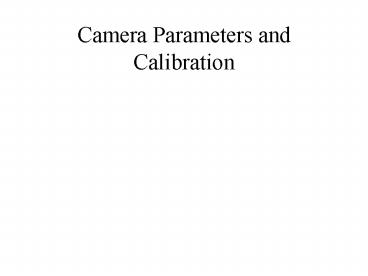Camera Parameters and Calibration - PowerPoint PPT Presentation
Title:
Camera Parameters and Calibration
Description:
Motion algorithm used to calibrate camera. Applications ... objects themselves are used to determine where the camera is, relative to the turntable. ... – PowerPoint PPT presentation
Number of Views:85
Avg rating:3.0/5.0
Title: Camera Parameters and Calibration
1
Camera Parameters and Calibration
2
Camera parameters
- From last time.
3
Homogeneous Coordinates (Again)
4
Extrinsic Parameters Characterizing Camera
position
Chasles's theorem Any motion of a solid body
can be composed of a translation and a rotation.
5
3D Rotation Matrices
6
3D Rotation Matrices contd
Eulers Theorem An arbitrary rotation can be
described by 3 rotation parameters
R
For example
More Generally
Most General
7
Rodrigues Formula
Take any rotation axis a and angle q What is
the matrix?
with
R eAq
8
Rotations can be represented as points in space
(with care)
Turn vector length into angle, direction into
axis Useful for generating random rotations,
understanding angular errors, characterizing
angular position, etc. Problem not unique Not
commutative
9
Other Properties of rotations
NOT Commutative R1R2 ? R2R1
10
Rotations
To form a rotation matrix, you can plug in the
columns of new coordinate points
For Example The unit x-vector goes to x
11
Other Properties of Rotations
Inverse R-1 RT rows, columns are
othonormal riT rj 0 if i?j, else riT
ri 1 Determinant det( R ) 1 The effect of
a coordinate rotation on a function x R x F(
x ) F( R-1 x )
12
Extrinsic Parameters
p R p t R rotation matrix t translation
vector In Homogeneous coordinates, p R p t
gt
13
Intrinsic Parameters
Differential Scaling
Camera Origin Offset
14
2D Example
- Rotation 90o
- Scaling 2
- Translation
House Points
p
15
The Whole (Linear) Transformation
Final image coordinates
u U/W v U/W
16
Non-linear distortions (not handled by our
treatment)
17
Camera Calibration
- You need to know something beyond what you get
out of the camera - Known World points (object)
- Traditional camera calibration
- Linear and non-linear parameter estimation
- Known camera motion
- Camera attached to robot
- Execute several different motions
- Multiple Cameras
18
(No Transcript)
19
Classical Calibration
20
Camera Calibration
Take a known set of points. Typically 3
orthogonal planes. Treat a point in the object
as the World origin Points x1, x2, x3, Project
to y1,y2,y3
21
Calibration Patterns
22
Classical Calibration
And projected points ui into a matrix
Put the set of points known object points xi into
a matrix
Note this is only for instructional purposes. It
does not work as a real procedure.
Solve for the transformation matrix
Odd derivation of the Least Squares solution
Next extract extrinsic and intrinsic parameters
from P
23
Real Calibration
- Real calibration procedures look quite different
- Weight points by correspondence quality
- Nonlinear optimization
- Linearizations
- Non-linear distortions
- Etc.
24
Camera Motion
25
Calibration Example (Zhang, Microsoft)
8 Point matches manually picked Motion algorithm
used to calibrate camera
26
Applications
Image based rendering Light field -- Hanrahan
(Stanford)
27
Virtualized Reality
28
Projector-based VRUNC Chapel Hill
29
Shader Lamps
30
Shape recovery without calibration Fitzgibbons,
Zisserman
Fully automatic procedure Converting the images
to 3D models is a black-box filter Video in,
VRML out. We don't require that the motion be
regular the angle between views can vary, and it
doesn't have to be known. Recovery of the angle
is automatic, and accuracy is about 40
millidegrees standard deviation. In golfing
terms, that's an even chance of a hole in one.
We don't use any calibration targets features
on the objects themselves are used to determine
where the camera is, relative to the turntable.
Aside from being easier, this means that there is
no problem with the setup changing between
calibration and acquisition, and that anyone can
use the software without special equipment. For
example, this dinosaur sequence was supplied to
us by the University of Hannover without any
other information. (Actually, we do have the
ground-truth angles so that we can make the
accuracy claims above, but of course these are
not used in the reconstruction).































